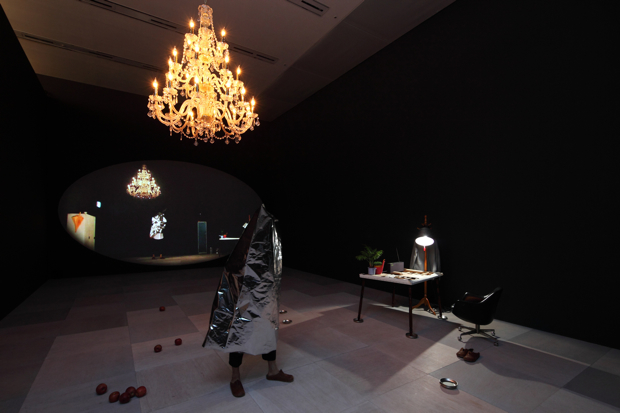When I read about the Cerith Wyn Evans work Everyone’s Gone to the Movies at London’s White Cube gallery, I was not struck so much by the strangeness of the fact that Evans had used heat as a medium, but the fact that he had put the “heat” segment of the show in the basement of the gallery. Having never been to White Cube, I at first had the impression that he had actually opened a part of the gallery not normally open to visitors, thereby leading them down into a superheated, hell-like space, where the disorientation of being removed from the accepted gallery space, coupled with the almost physical wall of heat, would take the visitor one step out of the ordinary.
A little reading soon straightened me out on the fact that the basement gallery is a fixture at White Cube. But the idea was planted, and soon enough I was noticing it everywhere.
I stumbled upon a work by Paul McCarthy at Palazzo Citterio in Milan, which did exactly what I had been imagining for Evans. While two video installations played through their bloody scenarios upstairs, he opened the basement of the building — a space not normally open to patrons — and set up Pig Island, a kind of behind-the-scenes workshop installation. While I find McCarthy’s work about as much fun as a root canal, and not half as deep, there is something about taking the audience into the gallery, and then removing them from it in unexpected ways that can often be far more effective than the white-painted attempt at making a gallery into some form of neutral space.
But there is a Tokyo show that came to mind after reading about Pig Island, and it’s one that’s still on: Yosuke Amemiya’s installation/performance work Whiplash Neuron, at the Mori Art Museum’s Roppongi Crossing exhibition. And while Amemiya didn’t open new, unseen sections of the gallery, he effectively created one instead.
The entrance to his performance is a single tiny door — barely large enough for a full-grown person to sneak through — at the end of a short, nondescript hallway. To a casual glance, the thing might be a service closet or fire extinguisher door. If it were not for a small plaque on the wall, you could easily walk right past. I have no doubt than many visitors probably did.
As you step through and close the door behind you, you find that you have stepped out of a fairly typical change-room locker. The room you are in now has no true doors. No entrances or exits. Like the children in the Narnia books, you have entered through a piece of furniture, and you find yourself in a room that seems suitably enchanted.
Unlike the white-walled gallery, the room is black and dark, and contains an odd assortment of objects: a desk, a chair, tin plates, apples, plastic bags, many of these things scattered around the floor. There is no clear place for the audience to stand, though most quickly gravitate toward the walls, as the artist himself moves through the room rearranging things and performing intent but esoteric actions. From time to time, he disappears into the other locker door, or into a kind of steel cabinet against another wall for several minutes (presumably to take a break). All the while, the video wall replays the actions of previous days or hours, and the room’s previous visitors stare back at you from the opposite side.
Amemiya has created a kind of non-space within the gallery, something that seems common to dreams — that dream of the hidden door in your room, leading to some undiscovered section of the house. The viewer remains in the gallery, but steps out of its well-defined and understood space. Suddenly one is contained by the artwork, and anything becomes possible. There is a quickening of the pulse, a doubt about where you ought to be. Can the objects be touched? Will you be accosted by this strange, intense man? Where to stand and not be in the way? All of these questions shake up the experience, question our relationship to the work and even the artist.
I enjoy these experiences, not only because they deconstruct gallery norms, but because they go beyond that to develop a cloud of choices for presenting art: not only in the gallery or outside of the gallery, but into the spaces that the gallery does not normally use; in invented spaces that do not appear to be the gallery at all; extending the show beyond the gallery and into the neighbourhood; causing the work to make the gallery inaccessible; or, as with Christo and Jeanne-Claude’s wrapped up Museum of Contemporary Art in Chicago, reversing the situation entirely and placing the gallery within the confines of the work.
And don’t even get me started on online spaces. That’s another blog.









